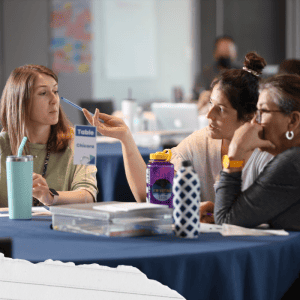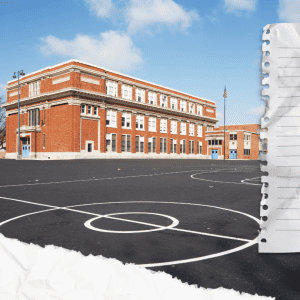
4 Mistakes to Avoid When Launching a New Curriculum
10/20/2023

Every day, students count on their teachers to nurture the knowledge and skills they’ll need for future success. One critical support in this endeavor is a high-quality curriculum. The benefits are clear:
- It offers a common foundation for lessons, so there’s no mystery about what students should be learning and what teachers should be teaching.
- It saves teachers the time of looking for materials so they can devote more of their energy to understanding their students’ strengths and using their creativity to bring engaging lessons to life.
- It fosters coherent experiences for students across classrooms and schools, making it easier for schools and districts to provide targeted support.
But with all of these benefits, implementing a new curriculum is often bumpy because it’s deeply human, adaptive work. Curriculum doesn’t teach—teachers do. Here are four common mistakes districts make when launching a new curriculum and how to avoid them.
#1: Not engaging teachers in the selection.
What happens: School systems often face urgency to get new materials to scale. Time is precious, and schools are still making up for significant unfinished learning since the pandemic. At the same time, leaders may fear that their decisions will be undermined by engaging a broader set of stakeholders in their selection process—namely, educators who already like the materials they have regardless of the rigor or standards alignment. These pressures can result in sidestepping.
Why this matters: Teachers worry that the curriculum is being done to them, not with and for them. Especially if teachers have never had centrally-provided resources before, they can sense a loss of creativity or agency. As leaders, it’s important to reset the false dichotomy that the curriculum is replacing teachers’ professional judgment, or your efforts may fail.
How you can avoid this hurdle: Start the process early. As the core users, teachers will have useful insights about what they want and need from their materials. Intentionally structuring their involvement, whether through a selection team, surveys, or other discovery methods will help you go further faster in the long run.
Consider this sample timeline from a Leading Educators district partner, built upon Instruction Partners’ Curriculum Support Guide phases:
#2: Not creating time for teachers to learn about innovations in high-quality instruction and materials.
What happens: With all that educators and leaders have to balance at once, there are often limited opportunities for teachers to understand the research base behind strong instructional materials. As a result, teachers opt to select materials that most closely match existing practices as opposed to ones that may be best aligned with research.
 Why this matters: Materials that don’t align with state standards and research are a shaky foundation for quality instruction and getting real outcomes. For example, using materials that do not address all aspects of research-based literacy may result in teachers having to constantly supplement materials. Worse yet, this may exacerbate gaps in access and students’ learning.
Why this matters: Materials that don’t align with state standards and research are a shaky foundation for quality instruction and getting real outcomes. For example, using materials that do not address all aspects of research-based literacy may result in teachers having to constantly supplement materials. Worse yet, this may exacerbate gaps in access and students’ learning.
How you can avoid this hurdle: Just as there is a wealth of affordable, high-quality curricula on the market, there is more knowledge than ever about assessing material quality. Use tools like the Instructional Materials Evaluation Tool (IMET), EdReports, the Council of the Great City Schools Quality Rubric, the Reading Leading League’s Curriculum Evaluation Guidelines, and Equip Science to establish what to look for. Within selection efforts alongside districts, we have also looked to tools like the Culturally Responsive Curriculum Scorecards to determine how particular curricula support students’ wholeness.
#3: Only thinking about launch training rather than building ongoing and sustained coherence.
What happens: Once materials are selected, many districts only offer teachers a couple of short days of professional development at the beginning of the year. Often, it’s about unboxing (and provided by the publisher) but not about teaching the material with effective practices.
Why this matters: Learning new materials is hard, professional work! Teachers benefit from robust opportunities to internalize their curriculum, plan, and practice new methods in collaboration. Quick-hit PD doesn’t afford them the time they need to truly experience the materials before they can use them well.
High-quality curricula often have beneficial instructional routines embedded. This can offer a powerful opportunity to renew teaching and norm on effective practices across a grade band. For example, the math language routines embedded in Illustrative Mathematics can be beneficial for multilingual learners by encouraging them to express their ideas and reasoning. Our research shows that ongoing and embedded support, including the opportunity to troubleshoot and plan together, is more likely to shift practices and increase teacher confidence and positive feelings about the curriculum.
How you can avoid this hurdle: Think about a long-term arc of training that balances internalization with ongoing practice and building of curriculum-specific practices. This can be done in cohort-based learning throughout the year, workshops, and/or school-based professional learning communities. Bringing in a partner can grow your capacity to provide job-embedded support, ongoing collaboration, and content coaching.
It may also be important to modify collaboration expectations and time to ensure instructional leadership teams are focused on the internalization of new materials rather than more generic planning processes.
#4: Messaging false choices between fidelity and how to adapt materials to meet different student needs.
What happens: Fidelity in curriculum implementation is tricky. Teachers need to know how materials were designed, but an overemphasis on fidelity in implementation can lead to the curriculum feeling like a deprofessionalizing compliance exercise.
Why this matters: Studies show that sequence matters in curriculum implementation. Students learn more when teachers focus on using the materials as designed in year one and move into adaptation in year two. It helps to first internalize the curriculum the way that it was intended and then build upon it, customize it, and make it more relevant to your specific students. That’s the true magic.
 How you can avoid this hurdle: Help teachers understand the research behind the curriculum’s structure. Model curiosity and open conversation about the intent. Focus on the load-bearing walls of the curriculum, the things that should not be changed no matter what. Make sure that the parts of the lesson are present. Then, when you’re further along, create a process and provide learning on how to adapt materials to maintain grade-level expectations while creating access for all students.
How you can avoid this hurdle: Help teachers understand the research behind the curriculum’s structure. Model curiosity and open conversation about the intent. Focus on the load-bearing walls of the curriculum, the things that should not be changed no matter what. Make sure that the parts of the lesson are present. Then, when you’re further along, create a process and provide learning on how to adapt materials to maintain grade-level expectations while creating access for all students.
Finally, build an interim assessment system aligned with the curriculum to monitor progress. To be clear, this can be a significant lift. It may require triangulating multiple assessments and data sources. But without aligned assessments, districts may abandon efforts too early.
Are you looking for support with launching a new high-quality curriculum?
Connect with our Partnerships team and learn how we can help.








